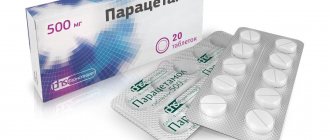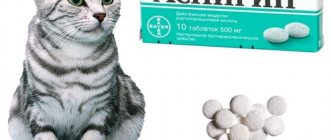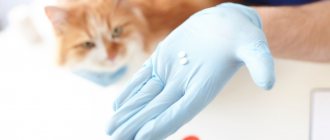Normal heart rate in a cat
Anyone who is used to monitoring their health knows that the pulse in adults ranges from 60 to 90 beats per minute, from 110-170 in infants and from 60 to 100 in adolescents. Unfortunately, not all owners know what a cat’s normal pulse is.
It is believed that in an adult healthy animal the pulse value ranges from 100 to 140 beats per minute
.
At the same time, large cats have a lower heart rate than their small counterparts, and females have a slightly higher heart rate than males. Kittens' pulse is always high: from 150 to 190 beats per minute
.
And a cat’s pulse at a very advanced age may be slightly lower than normal: 80-100 beats per minute.
Breathing assessment
This can be done by observation, counting the number of inhalations and exhalations in 30 seconds and multiplying this number by 2. Cats take between 20 and 40 breaths per minute.
In this case, you should keep in mind the age and gender of the animal. Kittens breathe more often than adult animals, cats breathe more often than cats, pregnant, lactating and medium-sized cats also breathe more often. In addition, a cat's breathing becomes more frequent in a state of excitement, increased activity, or in hot weather. If a cat's respiratory rate is above 40 per minute, observed for a long time and not caused by any of the factors listed above, this is a sign of ill health.
Methods for measuring heart rate in cats
Sometimes, in order not to miss any disease in your pet, it is enough to simply measure its pulse in time. Let's look at how this is done. We humans, when we want to count our heart rate, we squeeze the wrist area. Where is a cat's pulse? The easiest way for an animal to feel the pulsation of the large femoral artery is to press on the inside of the thigh (in the groin, where the cat's leg connects to the body). But here we note that some wayward pets may simply not allow the owner to touch the groin area. Otherwise, the pulse of a cat, cat or kitten can be measured by pressing the palm of the hand on the sternum area on the left side
(where you can feel the heartbeat).
The cat's pulse rate is usually measured over 1 minute. But what if the cat is indignant (breaks out, tries to bite, hisses, etc.)? Measurement time can be halved or quadrupled. For an aggressive pet, the measurement time can be reduced to 15 seconds, and then simply multiply the resulting value by 4 (the result of a 30-second measurement must be increased by 2).
When figuring out what your cat's heart rate is, it's important to keep these things in mind:
- Pulse counting should be done when the animal is as calm as possible
. An excited cat's pulse is always significantly higher than normal;
During the measurement, the owner should under no circumstances shout at the cat.
, hitting or squeezing it forcefully. This will cause the pulse of the unnerved animal to jump up;
Do not take the pulse of a sleeping pet
. During sleep, cats' heart rate is lower than when awake;
- There is no need to put too much pressure on the cat's groin or chest
. With strong pressure, it is difficult to calculate the pulse rate correctly.
How to measure your heart rate correctly
First of all, you need to know how to measure a cat’s pulse without having any special skills. In order to feel the pulse, we need to feel a large artery - it is in these vessels that the pressure is highest, and the movement of blood is well determined by the fingers.
You shouldn't do research after chasing a cat for two hours and trying to fish it out from under the sofa. It’s better to wait until the animal is lying quietly or sleeping, then the indicators will be most accurate, and you won’t have to think about what the cat’s pulse should be after physical activity.
The femoral artery is usually used to measure the pulse: it is quite close to the skin and is easy to find without special knowledge of animal anatomy. We place our palm on the cat’s inner thigh, press it against the body and feel a slight rhythmic pulsation - now we know where the pulse is measured most often in cats.
Of course, if it is impossible to determine it on the hip, you can carefully grab the animal’s throat or place your palm in the area of the first 5 ribs on the left, but these methods are less convenient and the animal may not like it.
After we have found the pulse, we note the time (1 minute, 30 or even 15 seconds) and count the number of beats. If you timed 30 seconds, multiply the value by 2, if 15, by 4. It’s better, of course, to time a minute at once, but this can be difficult to do for many reasons (due to the high heart rate of cats, it’s easy to lose count; a cat may not be able to withstand a minute in this position, etc.).
The cat's pulse is higher than normal
We found out above what a cat's pulse should be normally. But what if the pulse rate of an adult animal exceeds the specified limits, exceeding 150 beats per minute? Then we can safely talk about tachycardia
– pathological increase in heart rate. This is a dangerous disease that, if untreated, can lead to serious problems: ischemia, heart failure, thromboembolism, myocardial hypoxia, pulmonary edema and general deterioration of the body. If you do not seek medical help on time, unfortunately, death cannot be ruled out.
In addition to a rapid pulse, tachycardia in a cat can be recognized by the following symptoms:
Severe, persistent weakness (the cat looks tired even if it moves very little);
Arrhythmia (pulse is irregular, the heart beats either too quickly or too slowly);
Frequent breathing, shortness of breath even after a quiet walk;
Paleness of the mucous membranes;
The most common causes leading to the development of tachycardia in cats include:
- Heart disease (cardiomyopathy, myocarditis, etc.);
Diseases of the respiratory system, non-infectious and infectious (pulmonary failure, lung cancer, tuberculosis, pneumonia, etc.);
Endocrine disorders (diabetes mellitus, hyperthyroidism);
Inflammatory processes (pancreatitis, gastritis, colitis, endometritis, etc.);
If your cat's pulse is constantly elevated, you should visit your veterinarian (ideally, a veterinary cardiologist) as soon as possible. The specialist will take the animal’s blood and urine for analysis, conduct an electrocardiogram and echocardiogram, and, if necessary, an ultrasound and x-ray of the sternum and abdominal cavity. Treatment will be prescribed after an accurate diagnosis has been made. But we strongly recommend that you refrain from self-medication so that something irreparable does not happen.
The cat's pulse is below normal
Tachycardia or rapid pulse is a dangerous disease. What if the cat’s pulse is below normal? This is also bad: bradycardia
(low pulse) leads to severe weakness, the formation of blood clots, with this disease the internal organs are poorly supplied with blood and quickly fail. In addition, this is also dangerous, since with bradycardia, animals often lose consciousness.
Sometimes bradycardia is accompanied only by weakness, but in advanced cases the following symptoms may be present:
- Impaired coordination of movements (the cat has a “drunk” gait);
Jumps in blood pressure (normally, a cat’s blood pressure ranges from 105/65 to 135/95 mm Hg);
Bradycardia in a cat is not an independent disease. This is a symptom of other serious illnesses:
Pulse in cats: basic information and method of measurement
In films and books, a person who shows little or no signs of life is first checked for breathing and a pulse. And this is quite justified, by the way. In veterinary medicine, the pulse of a cat (or other animal) is also of no small importance, since its readings can be used to judge the general health of the pet, as well as determine the presence of certain pathologies of the cardiovascular system.
Symptoms
Oddly enough, an increase in heart rate of more than 140 per minute that occurs suddenly is usually well tolerated by patients. Such an attack can even last for several days, and the patient does not notice it or only feels weakness that is incomprehensible to him.
The more the heart muscle is affected and the more severe the heart disease, the more signs appear during an attack of tachycardia:
- chest pain;
- shortness of breath, lack of air, especially when lying down;
- sweating, severe weakness;
- dizziness, clouding of consciousness;
- fainting, loss of consciousness.
In the most severe cases, there is a risk of developing a stroke.
Basic information
Firstly, what is a pulse? These are vibrations of the walls of blood vessels through which not only blood flows, but also “recoil” from heart contractions. Naturally, this is typical exclusively for arteries, since blood flows through the veins to the heart, which draws it in like a living pump.
Normally, the heart rate of cats varies from 120 to 140 beats per minute . But it may be less if we talk about cats of “giant” breeds, like Maine Coons. How can you feel it in your pet? No, you don’t need to touch his paw, since in cats the pulse is found by pressing your palm to the inner surface of the thigh.
The femoral artery vibrates noticeably there, and therefore it will not be difficult to do this. Remember that kittens' heart rates are significantly higher than those of adult animals, so don't be alarmed if you lose count while trying to count them. In very young babies, the heart rate can easily reach 190 beats per minute. This is significantly higher than the normal heart rate in cats. But there is no need to worry, as this is a completely physiological phenomenon.
By the way, do not try to check the cat’s pulse by firmly grasping the cat by the throat (and such unique people really do exist). No, you can really determine the heart rate this way, but the animal will not be happy about it. In addition, his heart will be pounding from fear so that the correct readings will still not be obtained.
But what should you do if the cat is particularly chubby, or twitches its paws violently so that it becomes impossible to count the number of heartbeats? In this case, you should focus on the cardiac impulse. But how to measure a cat's pulse this way? This is the name for the “vibration” of the chest wall that occurs during heart contraction. It’s easy to determine: place your palm on the cat’s chest. After this, it will not be difficult to calculate the number of heartbeats, which will be similar to the pulse rate.
First aid
If an animal has choked on an object, you can try to get it out.
If a foreign object is suspected of entering the respiratory tract, the cat's jaw opens as much as possible. In this position, the owner needs to pick up the hard piece that is clogging the throat with his hands or tweezers. If you cannot get the object, then the animal must be turned upside down, tightly grasping its hind legs. With the other hand, press firmly, at intervals, on the tummy under the diaphragm. With this stimulation, the cat will be able to spit out the object.
If you suspect a heart attack, which can be determined by a change in pulse and cyanosis, the animal must be urgently taken to a veterinarian so that he can give an injection of medication. If a cat stops breathing, it needs to be resuscitated at home and then taken to the hospital. The algorithm of actions is as follows:
- The pet is placed on a table or floor so that the vertebrae are in line.
- Use cotton wool or a paper towel to remove discharge from the mouth.
- The jaws are clamped with one palm, and the second is rolled up into a tube in front of the muzzle. Powerful exhalations into the animal’s nose are shown at intervals of 2 seconds.
- If the heart does not beat, you need to start pressing rhythmically on the sternum.
Veterinarians note that with properly performed resuscitation, cats regain consciousness within 7-15 minutes.
What is the pulse like?
This question is very important. More precisely, the answers to it are important. So, the main type of pulse is normal. This means good content, low tension, rhythm... In short, there are a lot of incomprehensible words, the meaning of which is better described separately.
So what is filling? Roughly speaking, this is the quantity, the volume of blood in the artery. Poor filling, accordingly, is observed with severe dehydration, intoxication and other serious pathologies. When well filled, the vessel is elastic, but not “hard”. An increased value of this indicator may indicate various heart diseases, which, as a rule, are accompanied by edema.
Oddly enough, tension is not a convulsive contraction of the artery wall. This is the name given to the force required to compress the artery. Thus, poor tension can again only be observed in the case of dehydration, when even large vessels in their “consistency” can resemble boiled pasta. High tension - when the artery feels like a wire or branch. This happens when an animal’s blood pressure goes through the roof.
Everything is clear with rhythm. If the heart rate is similar to the efforts of a novice drummer, then the animal’s health is clearly not excellent. In addition, the pulse on different limbs can be different: different in filling, tension, and other parameters. This indicates different situations: either the animal has some congenital features in the development of the circulatory system, or something interferes with the normal passage of the pulse wave. This “something” may well be a tumor or similar pathology. Rhythm disturbances are combined under one term, arrhythmia.
Also, the pulse can be slow, normal and fast. These terms, as is easy to understand, mean the speed of propagation of the pulse wave. Accordingly, slow contractions occur either in a sleeping animal, or in an extremely exhausted and sick one. The pulse can be fast when there is strong excitement, but the heart rate also increases due to the action of various medications.
What is the pulse of a sick cat?
Full pulse is determined in hypertension. In case of hypotension, loss of blood, fainting, dehydration, tachyarrhythmia, the pulse will be empty, that is, difficult to palpate. An almost non-palpable pulse will occur when the animal is in a comatose or shock state, massive blood loss, or collapse.
Reasons for voltage changes
This characteristic is determined by the force that must be applied to completely compress the artery. The pulse should be of moderate tension.
With high blood pressure numbers, especially increased systolic pressure, the pulse may be hard. This indicates the need for medical intervention to prevent strokes or heart attacks.
A soft pulse characterizes the exact opposite state, that is, a decrease in blood pressure. This happens when there is blood loss and dehydration, due to a decrease in the tone of the vascular walls or the ineffectiveness of the contractile activity of the myocardium.
Reasons for changing frequency
The number of myocardial contractions per unit time is called the pulse rate. You need to understand that when determining the pulsation in the arteries on the inside of the animal’s thigh and the number of myocardial contractions, the numbers may differ. This happens when the myocardium sends too small portions of blood into the vascular bed (heart failure, blood loss, dehydration).
Tachycardia can be observed with anemia, infectious diseases that occur with an increase in body temperature, heat stroke, and endocrine disorders. With dehydration, stress, or shock, the pulse may also become shorter. Experts usually associate bradycardia with cardiovascular diseases.
Reasons for changing the pulsation shape
The shape is the rate at which the volume of the arteries changes. A fast pulse is a pulse in which the pressure increases greatly during systole and rapidly decreases during diastole. Such a pulse indicates insufficiency of the aortic valve apparatus, anemia, and fever.
A slow pulse characterizes the exact opposite situation to that described above. It occurs with a minimum pressure difference in the systole/diastole interval. Such a pulse may indicate a narrowing of the aortic ostium and insufficiency of the myocardial valve apparatus.
Dicrotic (double/two-humped pulse) occurs when blood hits a closed valve. This condition occurs in severe cardiomyopathies. Sometimes such a pulse is palpated in a young animal during an illness accompanied by fever.
Reasons for height changes
The amplitude of oscillations of the vascular wall is usually called the pulse height. The animal should have a uniform or moderate pulse in height.
High pulse amplitude is possible with aortic insufficiency, endocrine pathologies, and severe fever.
A cat may have a small pulse amplitude when the volume of circulating blood decreases, with heart failure, or stenosis of the aortic ostium in a state of shock.
Reasons for rhythm changes
Rhythm refers to the intervals between heartbeats (pulsations). At equal intervals, the pulse is considered rhythmic; at different time intervals between pulsations, they speak of arrhythmia. In general, arrhythmias include tachycardia, bradycardia and arrhythmia itself. Arrhythmias can be sinus and ectopic.
Relative and absolute (atrial and ventricular flutter). Arrhythmia characterizes various pathologies and myocardial defects.
What diseases cause changes in heart rate?
In general, we have already partially touched on this issue above, but it still wouldn’t hurt to reveal it in more detail. Most often, an increased pulse is detected, and this may be due to:
- Banal overheating.
- Almost any infectious disease.
- Emotional excitement, sexual desire. The latter is especially typical for March.
- Myocarditis in the initial stages. When the disease develops, the pulse slows down and its filling decreases.
- With many poisonings, the pulse also increases sharply at first, it is tense and very full, but subsequently all these indicators decrease just as much.
- A catastrophically strong decrease in filling is typical for cases of collapse.
How to measure a cat's pulse and temperature
The cat is one of the most popular pets. Often families have several cats. If you are one of the lovers of these graceful furry animals, you need to know what to do if your cat is sick. The veterinarian will likely ask you what the animal's temperature is and whether the animal's pulse is normal. How can you find out?
To take a kitten or adult cat's pulse, place your fingers on the inside of the back leg where it meets the belly. A large artery runs through this location, making it an ideal location for counting the animal's heart rate. Count the number of strokes in 15 seconds, and multiply the result by 4. If you keep your hand there for a short time, the cat is unlikely to object. The normal heart rate of a cat at rest is approximately 120 beats per minute (give or take 20 beats, depending on what the cat was just doing. If the pulse is significantly faster or slower, this means that the animal is unhealthy and you need to Contact your veterinarian. It will be useful to take your cat's pulse from time to time so that you know exactly how this is done and what value can be considered normal for your animal. It is best to take the pulse when the animal has been at rest for some time. If the cat gets used to this action, she won't mind you taking her pulse when she's sick. Another sign that a cat is sick is temperature. But measuring a cat's temperature is not as easy as feeling a child's forehead. Normal temperature for cats ranges from between 38 and 39 degrees. Anything below or above these values is a cause for concern. If you want to take a cat's temperature, it is necessary that there is good emotional contact between you, because this procedure is carried out using a rectal thermometer. You should use a plastic thermometer rather than a glass one, it is less dangerous. It is best to place the cat on the table (it must first be covered with a towel). Have someone else hold the cat's head and shoulders gently but firmly while you take the measurement and talk to it gently. The thermometer must be prepared: it must be clean and lubricated with Vaseline or oil. Make sure it shows normal temperature. Gently lift the cat's tail and coat the anus with Vaseline. Then very carefully insert the thermometer about an inch into the hole. Make sure the thermometer is inserted straight and not at an angle, otherwise you may injure your cat. You need to take the temperature within a minute. Then carefully remove the thermometer and look at the measurement result. If you are not completely sure that your cat will allow this procedure, leave it to your veterinarian.
Signs of disease in cats
The main sign that a cat is sick is a dry, hot nose. But this is not always correct. For example, immediately after sleep, a cat’s nose is dry and warm, but this does not mean that she is sick.
The very first thing that should alert you is the lack of appetite and apathy towards everything. The cat sleeps a lot and does not respond to your desire to communicate.
But there are diseases in which, on the contrary, activity, appetite and thirst are increased. The fur stops shining and sticks out in different directions. There may be discharge from the ears, eyes and nose. The eyes are half-closed with the third eyelid, and the pupils are dilated. Diarrhea, vomiting, difficulty urinating, temperature changes, breathing and pulse become erratic.
If you notice that the animal has begun to hide in dark places, this means that she is really unwell. Everyone has probably heard that a cat can heal itself. This is complete nonsense! The longer you wait for it to “cure” itself, the greater the percentage of death of the animal.
At the first signs of illness in your cat, you should first begin an examination yourself. First look at the fur, then pay attention to the eyes and nose for any discharge.
Look into your mouth; the oral cavity should be pale pink, without ulcers or stomatitis.
Pay attention to how she goes to the toilet, big and small, the nature and amount of discharge.
To carry out all these manipulations the cat needs to be restrained somehow; it is better to do this together. If your cat is of a calm disposition, then you can examine it alone, but if you have a “peppercorn”... First of all, call the cat gently to you, caress it, then take it by the back of the head with your left hand, by the hind legs with your right hand and lay it on its side. For extra confidence, you can wrap it in a blanket or towel.
How to measure a cat's temperature?
The cat's temperature can be measured with a regular mercury thermometer, or better yet, with an electronic one (faster, easier, safer).
Lubricate the tip of the thermometer with Vaseline, fix it, lift the tail and insert the thermometer “there” for a few minutes. Be prepared for resistance, and who will like this, even though the procedure is completely painless.
After measurement, the thermometer must be wiped and disinfected. Please note: a cat’s temperature is considered normal within 38-39 degrees; if above 39.5, this is already bad. But it happens that with some diseases the temperature can vary.
Determining the breathing rate
Well, everything is simple here, we count the number of inhalations and exhalations per minute. You can just watch the cats, you can put your hand on their stomach. In a healthy animal, the number of inhalations and exhalations is 18-32 times per minute. However, you should know that kittens breathe a little more often, cats breathe more than males, and pregnant or lactating women also breathe more often. Take into account what condition the cat is in: if she is at rest, she breathes less frequently, if she is hot, she has been running, or is nervous, she breathes more often. In general, if a cat breathes more than 30 times per minute and does not fall under any of the factors described above, and for a long time, it is a sign of illness.
Determining the cat's pulse
The pulse can be measured by placing your hand on the inner thigh, where the femoral artery passes. A normal heart rate is between 100 and 120 beats per minute. Again, there are some features that need to be taken into account: the age of the cat (it is higher in young ones), stuffiness, games and running, emotional state, also increase the heart rate. If your pet has a high temperature, it means she is breathing faster and has a high heart rate.
Capillary refill time
The cat's mucous membranes should be pink, not too pale, but not too bright. Wet, but not slippery. The amount of time it takes for the pale areas to turn a healthy pink color can tell a lot about your cat's condition. The normal capillary refill time is 2-3 seconds. Gently press your thumb onto the cat's mucous membrane (on the gum) and watch how quickly the pale area takes on a normal pink tint.
Cats cannot complain about their health themselves, so their health is in your hands. You should closely monitor your animal, and at the first sign of illness, change in appearance or behavior, check to see if the cat is sick. Any deviation from normal behavior is a cause for concern.
If normally your cat behaves independently, but suddenly seeks your company and does not leave a single step from you or, conversely, does not leave its place all day, then try to find out what happened. Don't think that a cat's purring is a sign of health.
Purring can sometimes indicate pain or illness. Unexpected aggression in an always calm and docile cat can be caused by pain, fever, concussion, infection, head injury, convulsions, or a diabetic crisis, which requires medical intervention.
In normal condition, cats, like people, breathe easily and naturally. It is quite difficult to notice this process from the outside. However, sometimes it is clearly visible that the cat often breathes from its stomach. At the same time, his sides rise, and his mouth is often slightly open. This condition cannot be called normal, although the causes are not always related to the disease.










